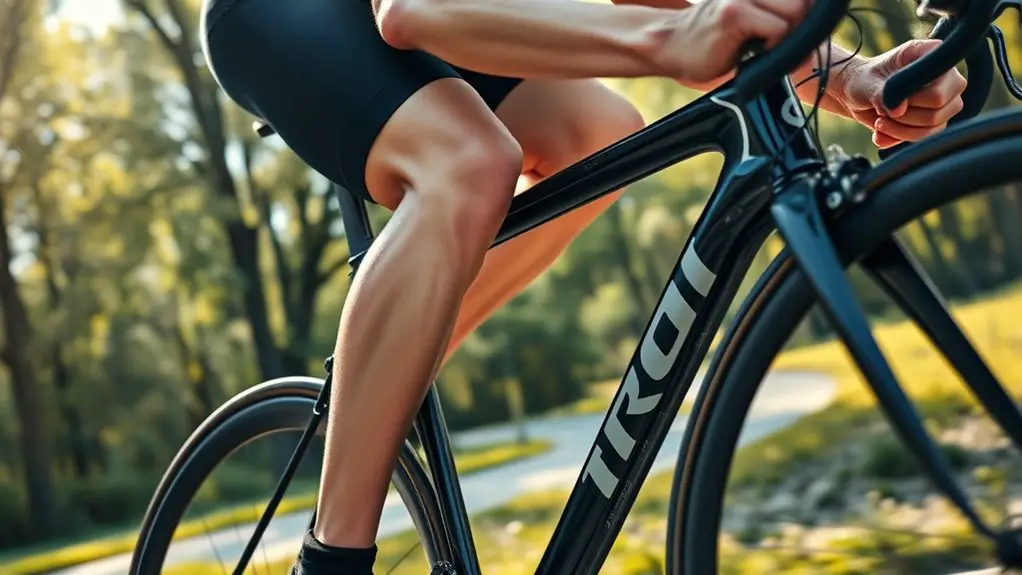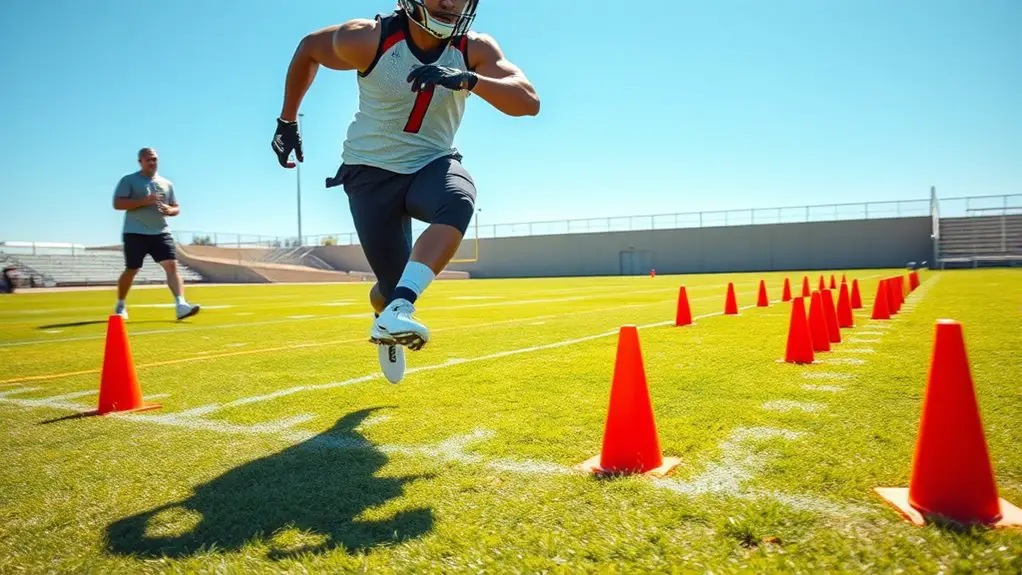To build acceleration for short-distance running, you should focus on your body mechanics, including arm swing and posture. Incorporate dynamic warm-ups and targeted drills like hill sprints and resisted sprints to enhance explosive power. Strengthening key muscles, such as your quadriceps and glutes, is essential for push-off. Proper nutrition also plays a role in your performance and recovery. There's more to uncover about optimizing your training and mindset for even better results.
Understanding Acceleration in Short-Distance Running
Understanding acceleration in short-distance running is vital because it sets the stage for your overall performance. When you take off from the starting line, that initial burst of speed can make all the difference. Acceleration isn't just about how fast you can run; it's about how quickly you can reach your top speed. You need to focus on your body mechanics, like your arm swing and posture, to maximize your power. The right mindset is important too—believing in your ability to spring forward with confidence helps release your potential. By honing your acceleration, you free yourself to explore the limits of your speed, allowing you to chase those personal records and feel the exhilarating rush of freedom that comes with every sprint.
The Importance of Proper Warm-Up Techniques
Before you hit the track, it is crucial to warm up properly to prepare your muscles and joints for the demands of short-distance running. A good warm-up isn't just a box to check; it sets the stage for your performance. Start with dynamic stretches that mimic your running motion, like leg swings or high knees. This gets your blood flowing and increases your range of motion. Don't forget to include some light jogging to gradually elevate your heart rate. By doing this, you reduce the risk of injury and enhance your overall speed. Remember, a well-executed warm-up can make all the difference, giving you the freedom to push your limits and achieve your personal best on the track.
Key Muscles Involved in Acceleration
After your warm-up, it's time to focus on the key muscles that drive acceleration in short-distance running. The primary players are your quadriceps, which extend your knees, and your hamstrings, which help pull your legs back. Your glutes are essential too, providing the power you need to push off the ground. Don't forget your calves; they play a significant role in the sprinting phase by propelling you forward with each push. Your core muscles, including the abdominals and lower back, stabilize your body and maintain balance during explosive movements. Strengthening these muscles will enhance your sprinting ability, allowing you to release your potential and experience the freedom of speed on the track. Embrace the power within you!
Essential Drills for Building Speed
To boost your speed, incorporating specific drills into your training is essential. These drills not only enhance your acceleration but also improve your overall performance. Here are three effective drills to include:
- Hill Sprints: Find a steep hill and sprint up it for 20-30 seconds. Walk back down to recover. Repeat several times for explosive power.
- Bounding: Perform exaggerated running strides, focusing on distance and height. This improves your leg strength and stride length.
- Resisted Sprints: Use a sled or resistance band to create drag as you sprint. This builds strength and speed when you run without resistance.
Integrating these drills into your routine will help you feel the freedom of faster, more powerful running. Enjoy the ride!
Optimizing Your Running Form
Running form is essential for maximizing your speed and efficiency on the track. To optimize it, focus on maintaining a straight posture with your head up and shoulders relaxed. Your arms should move in sync with your legs, driving forward rather than crossing your body. Keep your elbows at about 90 degrees, allowing for a powerful arm swing that helps propel you forward. Pay attention to your foot strike; landing mid-foot will help absorb impact and maintain momentum. Additionally, engage your core to stabilize your body and improve overall balance. Remember, every runner's form is unique, so find what feels natural for you. Embrace these adjustments, and you'll release your true potential, feeling the freedom of speed as you race ahead.
Strength Training for Sprinters
While speed is essential for short-distance running, strength training plays an equally important role in enhancing your performance. Building strength not only boosts your power but also helps prevent injuries. To get started, focus on these three key areas:
- Core Stability: A strong core keeps you balanced and efficient during sprints. Include planks and Russian twists in your routine.
- Leg Strength: Squats and deadlifts are fantastic for developing the muscles you'll rely on for explosive starts and speed.
- Upper Body Power: Don't neglect your arms! Push-ups and dumbbell presses can improve arm drive, which is vital for sprinting.
Incorporate these elements into your training, and you'll feel the difference in your performance on the track!
Plyometric Exercises to Enhance Explosiveness
Building strength is just the beginning when it comes to improving your short-distance running. To truly reveal your potential, you need to incorporate plyometric exercises. These explosive movements enhance your power and speed, giving you that edge you crave. Here's a quick look at some effective plyometric exercises:
| Exercise | Benefits |
|---|---|
| Box Jumps | Boosts leg power |
| Depth Jumps | Improves reactive strength |
| Broad Jumps | Enhances horizontal explosiveness |
| Tuck Jumps | Increases vertical leap |
The Role of Nutrition in Performance
How can the right nutrition impact your performance on the track? Fueling your body properly can make a world of difference when it comes to short-distance running. Here are three key factors to reflect on:
The right nutrition is crucial for optimal performance in short-distance running, influencing energy levels and recovery.
- Carbohydrates: These are your primary energy source. Loading up on complex carbs helps sustain your sprinting energy levels.
- Proteins: Essential for muscle repair and recovery, proteins help keep you strong and resilient, so you can push harder in each sprint.
- Hydration: Staying hydrated guarantees your muscles function effectively. Dehydration can slow you down and hinder your performance.
Mental Strategies for Sprinting Success
Nutrition plays an essential role in your physical performance, but mental strategies can elevate your sprinting to the next level. Visualize your race before you even step onto the track. Picture yourself exploding off the blocks and maintaining that fierce focus. Embrace positive self-talk; replace doubts with affirmations that boost your confidence. When you feel your mind racing, practice mindfulness to stay present and grounded. Set specific, achievable goals for each sprint, and break them into smaller steps to keep you motivated. Finally, cultivate a competitive yet relaxed mindset—pressure can hinder performance. Remember, sprinting is as much about mental freedom as it is about physical prowess. Trust yourself, and let your mind set you free on the track!
Monitoring Progress and Making Adjustments
As you train for short-distance running, monitoring your progress is essential for understanding what's working and what needs adjustment. Keeping track of your performance can free you to optimize your training. Here are three key areas to focus on:
- Timing: Use a stopwatch or app to record your sprint times. This'll help you gauge improvements and set realistic goals.
- Technique: Film yourself running to analyze your form. Small tweaks can lead to significant gains in speed.
- Recovery: Keep a log of your rest days and how you feel post-training. Adjusting your recovery plan can prevent burnout and injuries.
Frequently Asked Questions
How Does Weather Affect Short-Distance Running Acceleration?
Weather can really impact your short-distance running acceleration. Heat might drain your energy, while cold can stiffen muscles. Wind resistance can slow you down, so it's crucial to adapt your training to these conditions.
What Footwear Is Best for Sprinting Acceleration?
When it comes to sprinting acceleration, you'll want lightweight, flexible shoes with excellent grip. Look for options that provide support without weighing you down, ensuring your feet can move freely and quickly while maintaining traction.
Can I Improve Acceleration Without Running?
Yes, you can improve acceleration without running. Focus on strength training, plyometrics, and agility drills. Incorporate exercises like squats and box jumps, which enhance muscle power and explosiveness, giving you a solid foundation for your sprints.
How Often Should I Practice Acceleration Drills?
You should practice acceleration drills two to three times a week. Consistency's key, but don't overdo it; balance your training with rest days. Listen to your body, and adjust as needed for ideal progress.
What Role Does Rest Play in Acceleration Training?
Rest's like a chill day after a wild ride; it's essential for your body to recover and adapt. Without proper rest, you won't maximize your gains, so don't skimp on those recovery moments!




